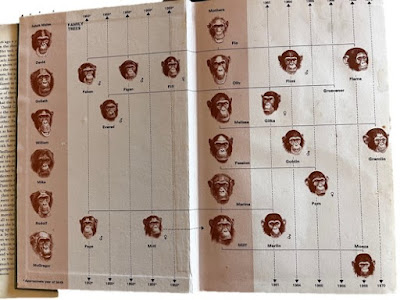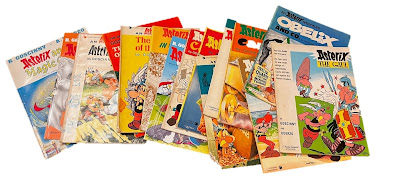Back in January I wrote a blog post bemoaning lazy cliches in movies and on TV. https://notablebrain.blogspot.com/2023/01/movie-cliches-tropes-and-memes.html This, in turn, was prompted by an earlier blog post grumbling about the gun-related cliches in the new Avatar movie. https://notablebrain.blogspot.com/2022/12/avatar-2-and-all-american-love-affair.html
Well, as often happens, those posts got me noticing plenty more lazy cliches that movie makers use; so here, just for you, are a few of them. You’re welcome…
1. PSYCHO KILLERS ALWAYS PASTE THEIR BEDROOM WALLS WITH NEWS
CUTTINGS. When the cop finally stumbles into the lair of the serial killer/psycho
that’s how we know they’ve found the bad guy.
2. OLDER COPS ARE JUST ABOUT TO RETIRE. One extra case eh…
3. SENIOR COPS ALWAYS
BAWL OUT THE GOOD COP. This seems to be a rule. There is always a more senior
cop usually with a glass fronted office that looks over the incident room, and
he (or she) is NEVER pleased with the way the case is going, never says, ‘well
done,’ usually threatens to take the good cop’s badge, and generally pulls the
good cop off the case.
4. IF THE SENIOR COP ALSO HAS A BOSS, THAT BOSS WILL BE BENT
5. COPS NEVER CATCH ANYONE IN A CAR CHASE. Did you ever see a
car chase where the cops catch the guy they’re chasing, even if they throw a
hundred cars at it? No. The guy (who is being chased by cops usually because of
a misunderstanding) always gets away.
6. WRITERS ALWAYS WEAR SPECS. Also they either live in a cabin by a lake or in a New York apartment.
7. HEROES ARE NEVER HAPPILY MARRIED. Usually the wife has died.
Or else they’ve had an undeserved separation. Whatever, they are now available
but only reluctantly.
8. TEENAGE SONS ARE ALWAYS REBELLIOUS. If the hero dad gives
his teenage son an order, you know the son will flagrantly ignore it in the
next scene. But in the end the teenage son comes good, sees the errors of his
ways, and makes up with the dad.
9. TEENAGE DAUGHTERS ARE ALWAYS SUPER SMART AND USUALLY ABOUT TO
GO TO HARVARD.
10. DOCTORS ARE ALWAYS READY TO TELL YOU HOW LONG YOU HAVE TO
LIVE. AND IT’S USUALLY JUST SIX MONTHS. But protagonists with six months left
always look reasonably fit, they don’t spend the six months suffering in bed,
they get out there and fight the bad guys.
11. NIGHTCLUBS/SEEDY DIVES ALWAYS HAVE A STRIPPER IN THE
BACKGROUND, BUT NOBODY IS ACTUALLY WATCHING HER
12. IF A MOVIE STARTS WITH A HAPPY COUPLE MOVING INTO A NEW
HOME, YOU KNOW IT WON’T TURN OUT WELL.
13. IF A MOVIE INVOLVES A SINGLE PERSON MOVING INTO A REMOTE
CABIN IN THE WOODS, THEN DITTO.
14. MOTHERS AND DAUGHTERS WILL ALWAYS QUARREL
15. THE HERO COP/DETECTIVE WILL CASUALLY SPOT A CLUE THAT THE
WHOLE CSI TEAM HAVE OVERLOOKED. Hmm. I wonder who left this cigarette butt …
16. IF A SCENE TAKES PLACE IN PARIS, YOU WILL ALWAYS BE ABLE TO
SEE THE EIFFEL TOWER IN THE BACKGROUND OR THROUGH A WINDOW. In London it’s
usually Big Ben.
17. THE BAD GUY’S HENCHMEN DIE FIRST. Finally he’s the last one
left alive, but he’s also the trickiest to kill. Also, have you noticed;
henchmen never have any lines. No henchman ever has a wisecrack, or says
something poignant while dying. A shot henchman simply does the decent thing
and dies quickly and quietly. Also where does the bad guy find all these
henchmen? Are they amazingly well paid? Do they get paid holidays? Do they
grumble over their conditions of employment?
Why are they always happy to do as they are told even when it looks as
if they’ll die doing it? Why do they never say: ‘hey, this isn’t my fight.
Leave me out of it.’ And on that subject ...
18. HELICOPTER PILOTS EMPLOYED BY VILLAINS ARE STUPIDLY RECKLESS. Where do you employ a guy who is happy to fly a helicopter into such a dangerous situation that he and his helicopter will end up as a massive fireball? There must be an agency somewhere specialising in suicidal pilots ...
19. THE UNIFORM ON THE PEG/DEAD GUY IS ALWAYS A PERFECT FIT WHEN
SOMEONE ELSE NEEDS IT. We never see a character struggling to get into a stolen uniform. A side door just opens and out they step, dressed up. And amazingly no one will question them.
20. WHEN THE BAD GUY GETS HIS CHANCE TO KILL THE GOOD GUY HE
ALWAYS CHOOSES NOT TO. Why would you do that?
21. BIG PHARMACEUTICAL COMPANIES ARE ALWAYS EVIL. So are the
billionaire owners of social media and tech companies except for Stark
Industries
22. IT IS REALLY EASY TO KNOCK SOMEONE UNCONSCIOUS. If you’re
cool and you know how.
23. IT IS REALLY EASY TO KICK DOWN A DOOR. If you’re cool and
you know how.
24. IT IS REALLY EASY TO SNATCH A GUN OUT OF AN ANTAGONIST’S HAND.
If you’re cool and you know how.
25. IT IS REALLY EASY TO HACK INTO JUST ABOUT ANY COMPUTER. If
you’re uncool and a nerd hacker.
26. IT IS ALWAYS EASY TO PARK. There is always a convenient
space.
27. GIRL WAKES UP IN BED – WONDERS WHERE HER LOVER FROM THE
NIGHT BEFORE HAS GONE – DON’T WORRY – HE’S COOKING UP BREAKFAST. And actually
he’s an amazing cook. Who would have guessed?
28. IF THERE IS A POKER GAME – SOMEONE WILL ALWAYS HAVE AN
UNBELIEVABLE HAND. One protagonist has a once in a lifetime hand. But what do
you know. Someone else at the table has a better one.
29. IF THERE IS A CHESS GAME IN PLAY, IT IS ONLY EVER ONE MOVE
AWAY FROM CHECKMATE.
30. IT ONLY TAKES A SECOND TO PAY FOR A CAB. Movie people just
pass over a banknote and get out without speaking.
31. IF YOU CHASE ANYONE DOWN AN ESCALATOR AT A TUBE STATION,
GUESS WHAT? THERE WILL BE A TRAIN RIGHT THERE AT THE PLATFORM (OR JUST ARRIVING) FOR THEM TO HOP
ONTO. Yet whenever I run down an escalator at a tube station I find I just missed the train.
32. THE HERO ALWAYS MISSES HIS DAUGHTER'S BIRTHDAY PARTY / CONCERT. It isn't his fault. He'll be forgiven at the end.
I'm beginning to think this is an almost endless seam to be mined. If you've spotted any more lazy tropes, let me know, or drop them into the comments. I daresay I'll keep noticing them.
Please check out my website for more information on my books. https://www.johnironmonger.com





















.jpg)













.jpg)